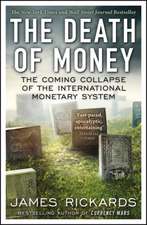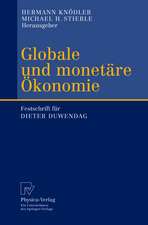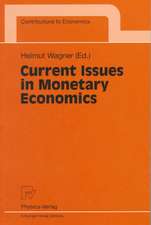The Role of Financial Markets in the Transition Process: Contributions to Economics
Editat de Emilio Colombo, John Driffillen Limba Engleză Paperback – 10 ian 2003
Din seria Contributions to Economics
- 18%
 Preț: 1001.81 lei
Preț: 1001.81 lei -
 Preț: 90.83 lei
Preț: 90.83 lei - 15%
 Preț: 649.06 lei
Preț: 649.06 lei - 18%
 Preț: 1109.92 lei
Preț: 1109.92 lei - 24%
 Preț: 657.09 lei
Preț: 657.09 lei - 18%
 Preț: 976.54 lei
Preț: 976.54 lei - 17%
 Preț: 361.03 lei
Preț: 361.03 lei - 18%
 Preț: 1027.83 lei
Preț: 1027.83 lei -
 Preț: 283.93 lei
Preț: 283.93 lei - 15%
 Preț: 644.95 lei
Preț: 644.95 lei - 15%
 Preț: 638.24 lei
Preț: 638.24 lei -
 Preț: 394.29 lei
Preț: 394.29 lei - 15%
 Preț: 636.80 lei
Preț: 636.80 lei - 15%
 Preț: 637.78 lei
Preț: 637.78 lei - 18%
 Preț: 723.69 lei
Preț: 723.69 lei - 15%
 Preț: 635.47 lei
Preț: 635.47 lei - 15%
 Preț: 634.00 lei
Preț: 634.00 lei -
 Preț: 392.75 lei
Preț: 392.75 lei -
 Preț: 383.33 lei
Preț: 383.33 lei - 15%
 Preț: 637.28 lei
Preț: 637.28 lei - 15%
 Preț: 636.80 lei
Preț: 636.80 lei - 18%
 Preț: 950.96 lei
Preț: 950.96 lei - 15%
 Preț: 634.68 lei
Preț: 634.68 lei -
 Preț: 387.38 lei
Preț: 387.38 lei - 15%
 Preț: 647.27 lei
Preț: 647.27 lei - 15%
 Preț: 636.63 lei
Preț: 636.63 lei - 15%
 Preț: 639.73 lei
Preț: 639.73 lei -
 Preț: 385.62 lei
Preț: 385.62 lei - 15%
 Preț: 641.85 lei
Preț: 641.85 lei - 20%
 Preț: 649.60 lei
Preț: 649.60 lei - 15%
 Preț: 641.71 lei
Preț: 641.71 lei -
 Preț: 387.96 lei
Preț: 387.96 lei - 15%
 Preț: 645.47 lei
Preț: 645.47 lei -
 Preț: 385.08 lei
Preț: 385.08 lei - 15%
 Preț: 646.62 lei
Preț: 646.62 lei -
 Preț: 383.33 lei
Preț: 383.33 lei - 15%
 Preț: 638.43 lei
Preț: 638.43 lei -
 Preț: 381.21 lei
Preț: 381.21 lei - 15%
 Preț: 642.51 lei
Preț: 642.51 lei - 15%
 Preț: 637.78 lei
Preț: 637.78 lei - 15%
 Preț: 641.71 lei
Preț: 641.71 lei -
 Preț: 384.70 lei
Preț: 384.70 lei -
 Preț: 379.86 lei
Preț: 379.86 lei -
 Preț: 378.34 lei
Preț: 378.34 lei -
 Preț: 384.70 lei
Preț: 384.70 lei -
 Preț: 388.52 lei
Preț: 388.52 lei - 15%
 Preț: 641.71 lei
Preț: 641.71 lei -
 Preț: 381.00 lei
Preț: 381.00 lei - 15%
 Preț: 644.95 lei
Preț: 644.95 lei -
 Preț: 386.00 lei
Preț: 386.00 lei
Preț: 385.84 lei
Nou
Puncte Express: 579
Preț estimativ în valută:
73.84€ • 80.18$ • 62.02£
73.84€ • 80.18$ • 62.02£
Carte tipărită la comandă
Livrare economică 23 aprilie-07 mai
Preluare comenzi: 021 569.72.76
Specificații
ISBN-13: 9783790800043
ISBN-10: 379080004X
Pagini: 240
Ilustrații: VIII, 228 p. 6 illus.
Dimensiuni: 155 x 235 x 13 mm
Greutate: 0.36 kg
Ediția:Softcover reprint of the original 1st ed. 2003
Editura: Physica-Verlag HD
Colecția Physica
Seria Contributions to Economics
Locul publicării:Heidelberg, Germany
ISBN-10: 379080004X
Pagini: 240
Ilustrații: VIII, 228 p. 6 illus.
Dimensiuni: 155 x 235 x 13 mm
Greutate: 0.36 kg
Ediția:Softcover reprint of the original 1st ed. 2003
Editura: Physica-Verlag HD
Colecția Physica
Seria Contributions to Economics
Locul publicării:Heidelberg, Germany
Public țintă
ResearchCuprins
1 Financial Markets and Transition.- 1.1 Introduction.- 1.2 Theoretical Background.- 1.3 Empirical Evidence.- 1.4 Financial Market Imperfections in Eastern Europe.- 1.5 The Aim of this Volume.- References.- 2 The Order of Financial Liberalisation: Lessons from the Polish Experience.- 2.1 Introduction.- 2.2 Institutions and Sources of Finance.- 2.3 Privatisation, Restructuring and Enterprise Finance.- 2.4 Conclusions.- References.- 3 Economic and Financial Transition in Hungary.- 3.1 Introduction.- 3.2 Macroeconomic Developments and Transition Progress.- 3.3 Financial Developments.- 3.4 Issues in Financial Development.- 3.5 Challenges Ahead.- References.- 4 Endogenous Startups, Financial Conditions, and Capital Accumulation.- 4.1 Introduction.- 4.2 The Basic Model.- 4.3 Public Expenditure Financed by Labor Income Taxes.- 4.4 An Open Economy in a Fixed Exchange Rate Regime.- 4.5 Conclusions.- References.- 5 Wealth Distribution, Occupational Choice and the Behaviour of the Interest Rate.- 5.1 Introduction.- 5.2 Model Economy.- 5.3 Equilibrium Conditions and Factor Prices.- 5.4 Market Equilibrium Dynamics.- 5.5 Development and Inequality.- 5.6 Some Empirical Evidence in Eastern Europe.- 5.7 Conclusions.- References.- 6 Financial Instability in the Transition Economies: Lessons from East (Asia) for (East) Europe.- 6.1 Introduction.- 6.2 Is the Diamond-Dybvig Approach Relevant for Banking Policy in Transition Economies?.- 6.3 The Model.- 6.4 The Social Planner Problem.- 6.5 The Role of the Banking System.- 6.6 Liquidity Requirements as a Means to Preserve Financial Stability.- 6.7 Financial Instability and External Shocks: The Case of Foreign Interest Rate Shocks.- 6.8 Conclusions.- References.- 7 Foreign Direct Investment in the Banking Sector: Experiences and Lessons from CEECs.- 7.1 Introduction.- 7.2 FDI in the Banking Sector: Are Transitional Economies Special?.- 7.3 Data on FDI in TE Banking Sectors.- 7.4 Impact of FDI in the Banking Sector.- 7.5 Determinants of FDI Localization in the Banking Sector.- 7.6 Conclusions.- References.- 8 Corporate Capital Structure in Transition: Evidence from Hungarian and Czech Firms.- 8.1 Introduction.- 8.2 Determinants of Leverage in TEs: Theoretical Issues.- 8.3 Data Set and Descriptive Statistics.- 8.4 Empirical Analysis.- 8.5 Conclusions.- References.- 9 Financing Patterns in Hungary — as Seen from Balance Sheets and from Interviews.- 9.1 Introduction.- 9.2 Analysis of Financial Accounts of Companies.- 9.3 Survey Findings.- 9.4 Summary and Lessons.- References.
Caracteristici
Includes supplementary material: sn.pub/extras




















